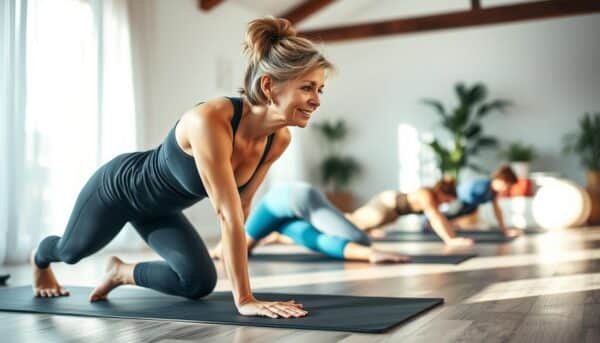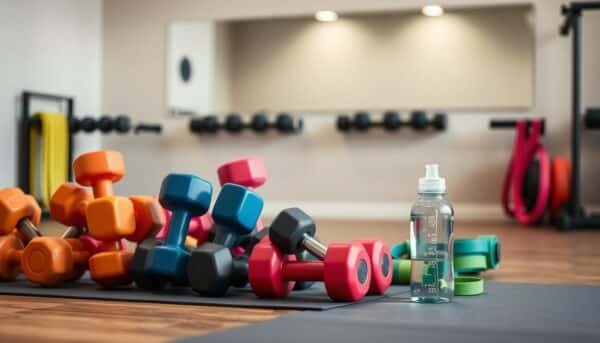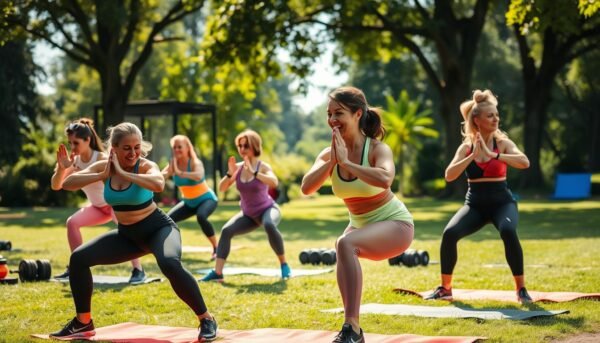As a woman over 40, finding motivation to start a new fitness journey can be tough. I fractured my sacrum at 40 and decided to get fit. Weight lifting became key to my transformation.
I started with light weights and used free resources like the Peloton app. This journey boosted my strength and improved my mood and energy. It’s changed my life for the better.
In this guide, I share my experience to help women over 40 start their weight lifting journey. Whether you want to lose 50 pounds or just be healthier, this program is for you. It’s easy to follow and will help you succeed in your weight loss journey.
Understanding the Fundamentals of Weight Training After 40

As we get older, our bodies change. We lose muscle mass, which affects our strength and mobility. But, weight training can help women over 40 stay strong and healthy.
Basic Equipment Needed to Start
You don’t need a fancy gym to start weight training. Just bodyweight exercises, resistance bands, and dumbbells or kettlebells. These tools help you work out all major muscles and build strength.
Setting Realistic Expectations
When starting weight training, have realistic goals. Muscle growth and strength gains may take longer than when you were younger. But, keep at it and celebrate your small wins.
Safety Considerations for Mature Bodies
It’s vital to be safe while weight training as you age. Use lighter weights and focus on proper form to avoid injuries. Always warm up, cool down, and listen to your body. This way, you can enjoy the strength training benefits safely.
Learning the basics of weight training opens doors for women over 40. It helps build muscle mass and boosts weight training for women. With the right mindset, you can see the amazing health benefits of strength training.
The Science Behind Strength Training and Aging

As we get older, our bodies change a lot. One big change is losing muscle mass, called sarcopenia. After 30, we might lose 3-8% of muscle each decade. But, strength training can slow down this loss and bring many benefits.
Strength training keeps muscle mass and boosts bone density, which helps prevent osteoporosis. A 2017 study found that 30 minutes of high-intensity training twice a week made bones stronger in postmenopausal women.
Strength training does more than just help muscles and bones. It also helps keep our metabolism healthy. Muscle burns more calories than fat, which is great for staying at a healthy weight. It also lowers the risk of chronic diseases like type 2 diabetes.
| Benefit | Impact |
|---|---|
| Muscle Loss Mitigation | Strength training can help preserve muscle mass and prevent the 3-8% decline per decade after age 30. |
| Bone Density Improvement | Just 30 minutes of high-intensity resistance training twice a week can increase bone density in postmenopausal women. |
| Metabolic Health Enhancement | Muscle tissue is more metabolically active, helping to maintain a healthy weight and reduce the risk of chronic conditions like type 2 diabetes. |
The science is clear: strength training fights aging’s effects on our bodies. Adding it to our workouts helps keep muscle, strengthen bones, and boost metabolism. These are key for staying lively and healthy as we age.
How to lose 50 pounds Through Weight Training

Starting a weight loss journey can seem hard. But, with the right steps, it’s doable. Weight training is a great way to lose weight. A 2017 study showed that those who did strength training four times a week for 18 months lost about 18 pounds of fat. This is more than those who didn’t exercise or did only cardio.
By combining regular workouts with healthy eating, you can lose 50 pounds. This will change your body for the better.
Creating a Sustainable Workout Schedule
Being consistent is key to losing weight. Start with 2-3 strength training sessions a week. Focus on exercises that work many muscles at once.
As you get better, you can do more workouts. But, don’t push too hard. This can cause burnout and injuries.
Combining Strength Training with Proper Nutrition
What you eat is also important for losing weight. Try to eat fewer calories than you burn. A 500-calorie deficit each day can help you lose 1 pound a week.
Eat foods that are full of nutrients like lean proteins, veggies, and whole grains. Also, eat at the right times to avoid eating too much.
Tracking Progress and Adjusting Goals
It’s important to track your progress. Use the scale, take body measurements, and check how your clothes fit. You can also take progress photos.
When you reach your goals, change them to keep the challenge alive. This will keep you motivated and feeling accomplished.
Remember, losing weight is a journey, not just a goal. By sticking to a good workout and eating plan, you can lose 50 pounds. This will improve your body and health.
Essential Strength Training Movements for Beginners

For beginners over 40, it’s best to focus on compound exercises. These exercises work many muscles at once. They also help you get stronger and burn calories faster than single-muscle exercises.
Compound Exercises
- Squats: This exercise targets your legs and glutes. Start with bodyweight squats and add weights later.
- Lunges: Try different types of lunges to work your legs and improve balance.
- Push-Ups: This exercise works your chest, shoulders, and arms. Make them easier by doing them on an incline or against a wall.
- Rows: Rows work your back and improve your posture. Use dumbbells, bands, or a row machine.
- Planks: This exercise strengthens your core, from abs to lower back.
Begin with 2-3 sets of 8-12 reps for each exercise. Focus on form to avoid injury and get the most benefits. As you get stronger, add more weight or resistance.
Dumbbell Exercises
Dumbbell exercises are great for building strength and improving balance. Here are some good ones for beginners:
- Dumbbell Shoulder Press: Strengthens your shoulders and upper back.
- Dumbbell Bicep Curls: Works your biceps for stronger arms.
- Dumbbell Deadlifts: Targets your hamstrings and lower back.
It’s important to use proper form with dumbbells. Start with light weights and focus on controlled movements. This helps you avoid injury and work the right muscles.
Bodyweight Workouts
Bodyweight exercises are perfect for beginners or those who like simple workouts. Here are some effective ones:
- Push-Ups
- Squats
- Lunges
- Planks
- Glute Bridges
Bodyweight workouts are easy to do anywhere. They’re a great way to start building strength. As you get stronger, you can add resistance bands or weighted backpacks to make it harder.
For beginners over 40, start with the basics and focus on form. Gradually increase the intensity and weight as you get stronger. By doing these exercises, you’ll build a stronger, more resilient body.
Building Core Strength and Stability First

A strong core is key for overall strength and stability. It improves your posture and balance. It also makes other exercises more effective. Let’s explore the best core exercises, how to do them right, and how to get better at them.
Foundational Core Exercises
Start with basic core exercises that target your midsection’s deep muscles. These include:
- Plank: Hold a high plank, engaging your core and glutes. Keep a straight line from head to heels.
- Bird Dog: On all fours, extend one arm and the opposite leg. Keep your spine neutral.
- Dead Bug: Lie on your back, arms overhead, and legs extended. Lower one arm and leg while keeping your core tight.
Proper Form and Breathing Techniques
It’s important to do these exercises right to engage your core and avoid injury. Imagine someone is about to punch you in the stomach as you do them. Breathe out when you’re working hard and breathe in when it’s easier.
Progressive Core Training Methods
After mastering the basics, try harder exercises. Some examples are:
- Russian Twists: Sit on the floor, lean back, and twist your torso. Tap the floor with your hands.
- Bicycle Crunches: Lie on your back, bring one knee to your chest, and twist to touch the opposite elbow.
- Stability Ball Exercises: Do planks, Pike push-ups, and ab roll-outs on a stability ball. It’s harder and challenges your core.
A strong core does more than just make your stomach flat. It improves your posture, balance, and makes other exercises better. Do core workouts 2-3 times a week for the best results.
Upper Body Training: Starting Small and Growing Strong

Building upper body strength is key for women over 40. Start with basic exercises for arm exercises, shoulder workouts, and chest press. Focus on proper form and increase weight slowly to build strength safely.
Begin with light weights, like 2-4 kg dumbbells. Do bicep curls, tricep extensions, shoulder presses, and chest presses. Do 2-3 sets of 10-15 reps, keeping good form. Increase weight as you get stronger, but always keep proper technique.
A good upper body workout includes pushing and pulling exercises. This ensures your muscles grow evenly. Try inverted rows, barbell bent-over rows, and dumbbell bench presses.
- Bicep Curls: 3 sets of 12 reps
- Tricep Extensions: 3 sets of 10 reps
- Shoulder Presses: 3 sets of 8 reps
- Chest Presses: 3 sets of 10 reps
Regular upper body workouts, a balanced diet, and enough rest are essential. Visible muscle in women is a sign of health and fitness, not bulk. Enjoy the journey and celebrate your progress as you get stronger and more confident.
Lower Body Exercises for Maximum Fat Burning

Lower body exercises are key for burning fat. They work big muscles in your legs and glutes. This boosts your metabolism and helps you lose weight.
Squat Variations for Beginners
Start with bodyweight squats to learn the right form. Then, try a dumbbell goblet squat to add weight. Keep your chest up, engage your core, and push through your heels.
Lunge Progressions
Start with static lunges to focus on form and balance. Move to walking lunges to work your legs, core, and stabilizers more. This builds strength and burns calories.
Hip Strengthening Movements
Do exercises like glute bridges and clamshells to strengthen your hips. These work your glutes, which are key for strength and stability. Add weights or bands as you get stronger.
| Exercise | Target Muscles | Calories Burned (per minute) |
|---|---|---|
| Deadlifts | Glutes, Hamstrings, Core, Back, Trapezius | – |
| Squats | Quads, Hamstrings, Glutes, Core, Calves | – |
| Sumo Squats | Quadriceps, Hamstrings, Glutes, Adductors, Calves, Hip Flexors | – |
| Bulgarian Split Squats | Quads, Hamstrings, Glutes, Calves, Core | – |
| Weighted Glute Bridge | Gluteus Maximus, Hamstrings, Transversus Abdominis | – |
| Lateral Lunges | Quadriceps, Abductors, Glutes, Adductors, Hamstrings | – |
| Squat to Press | Glutes, Shoulders, Arms, Core, Quads, Hamstrings, Anterior Deltoid, Lateral Deltoid, Triceps | – |
| Walking Lunges | Quads, Hamstrings, Glutes, Calves, Transverse Abdominis, Obliques, Multifidus, Erector Spinae | – |
| Isometric Calf Raise | Calf Muscles | – |
| Single Leg Deadlift | Glutes, Quads, Hamstrings, Core, Lower Back | – |
| Curtsy Lunges | Hips, Thighs, Buttocks | – |
| Step-ups | Quadriceps, Hamstrings, Glutes | – |
Combining these glute exercises and leg workouts boosts fat burning and strength. Increase the challenge to keep improving.
Recovery and Rest: Essential Components of Success

Starting your weight lifting journey? It’s key to know how important recovery and rest are. Your muscles grow and repair when you rest. So, getting enough rest is crucial for progress and staying injury-free.
Aim for 7-9 hours of quality sleep per night to help your muscles recover and hormones stay balanced. Sleep is when your body fixes and builds muscle. Good sleep habits are essential. Also, do yoga or light walks on rest days to ease muscle soreness and boost blood flow.
Good food and water are also vital for recovery. Make sure you eat enough protein, carbs, and healthy fats to feed your muscles and refill energy. Drink lots of water to help your muscles recover and reduce stress.
Pay attention to how your body feels and adjust your workouts if needed. Too much training can cause burnout, increase injury risk, and hurt muscle recovery and sleep. Give your muscles time to rest between workouts. And don’t hesitate to take an extra day off if you need it.
Remember, recovery and rest are as important as your workouts. By focusing on these, you’ll make steady progress, avoid injuries, and achieve great results in your weight lifting journey.
Nutrition Strategies to Support Muscle Growth
Starting my weight training journey, I learned how important nutrition is. As a woman over 40, I need to focus on protein. This helps my muscles recover and grow.
Protein Requirements for Women Over 40
Research says women over 40 need 1.2-1.6 grams of protein per kilogram of body weight daily. Good protein sources are lean meats, fish, eggs, and plant-based foods like legumes and tofu. Eating a variety of these foods helps me meet my protein needs.
Meal Timing Around Workouts
It’s key to eat right before and after workouts. Eating protein and carbs within an hour after helps my muscles recover. This way, I get the most from my strength training.
Hydration Guidelines
Drinking enough water is also crucial. I try to drink at least 8 glasses a day. This keeps me healthy and helps my muscles recover.
This post may contain affiliate links which means I may receive a commission for purchases made through links. I will only recommend products that I have personally used! Learn more on my Private Policy page.